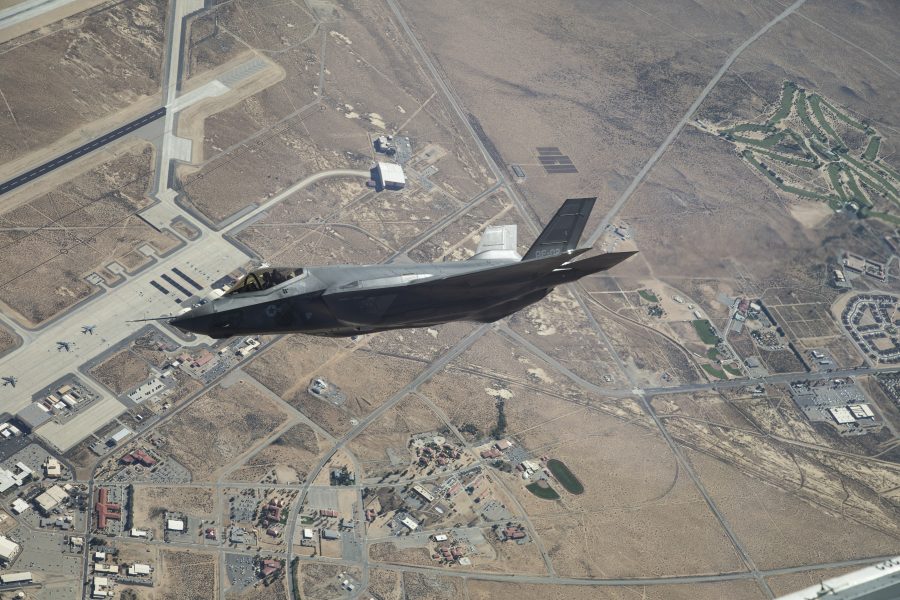Flight testing and other technical evaluations are starting up again at Edwards Air Force Base, Calif., and other locations, after a pause due to the COVID-19 pandemic, Air Force Materiel Command chief Gen. Arnold Bunch Jr. said.
Top priorities include the F-35, A-10, Jolly Green II, and C-17s with biological isolation pods, Bunch said in a March 31 telephone interview with Air Force Magazine, citing critical demand. Efforts are being made to protect Airmen and civilian workers as the test apparatus is brought back up, and to ensure that if someone tests positive for COVID-19, it doesn’t wipe out an entire critical element of the test enterprise.
“We were not flying at Edwards. That ramps back up this week,” Bunch said. Testing of a new F-35 transparency, to verify a new vendor for that item, is first up. “We felt it was the right risk to take,” he said, noting the work is critical to keep that program on track. Other programs that will start coming back “will be F-22s and the C-17. … We’ll execute those, learn from those, and then we’ll go from there,” he said.
At other bases, such as Eglin Air Force Base, Fla., “as far as I know, we’ve been flying all the platforms we’ve got there, we’re doing tests and continuing to execute. Maybe not as fast as we were, but we’re executing test.” He said “urgent operational need” programs are getting top priority for limited test assets.
At Edwards, “It took us a little bit of time” to work out procedures that would determine minimum numbers of people needed to conduct a test, keep them separated, figure out how to clean the control rooms, how to do the instrumentation, etc. Control rooms—which resemble NASA’s “mission control” for space activities—monitor weather, telemetry, chase aircraft, air traffic, cameras, threat duplicators, etc. for system tests. They can have more than 50 people in them, which is not allowed under current restrictions in California and elsewhere.
Similarly, AFMC is splitting maintenance and other crews in half, so only a portion of a skilled workforce is potentially exposed at any given time. This is to “make sure I don’t have all our maintainers in at the same time … What I want to avoid is, having a team … with one [person] test ‘positive’ and wipe out a test capability, because we’ve got to quarantine a bunch of people for weeks at a time,” Bunch explained.
Bunch said the test centers are working with Program Executive Officers to rack and stack test programs to accommodate “who has a critical milestone coming up, which sorties you have to get.” Testing of the A-10 upgrade is proceeding at Davis-Monthan Air Force Base, Ariz., though the program is actually managed out of Eglin.
Another priority is hypersonics testing, Bunch said. “Arnold’s been doing arc jet heater testing, that’s a critical resource,” Bunch noted.
“We’re just trying to take smart looks at how do we do this so we support the important things, … but we [need to] sustain our test force, everybody in the enterprise, for the longer term, so that as the risk of spread goes down in the local areas, we can ramp back up.”
The Jolly Green II is “another one that we worked with the local community and others to get the right people in, so we can keep testing on that program … at Eglin.”
Bunch is pushing authority to make such decisions down to facility commanders, because the circumstances, risk, and priority are different throughout the test community. Significant testing is taking place at Edwards, Eglin, Arnold Engineering Center, Tenn., and Holloman Air Force Base, N.M., as well as “30 other geographically separated locations” that are validating software or doing other evaluations.
“Each of those local commanders has got to make that call based on our support of the local community, … knowing that we have a national mission, we have to continue to execute,” Bunch said. He said he trusts them to make the right calls because “they have the best info, the best onsite knowledge of what’s going on … That’s consistent with how we do our business. We push it out to the local commanders and let them make decisions, and then we support them.”
Although AFMC had a “playbook” for dealing with outages of capability, it was built around hurricanes and “a snow day,” it was not intended for long-lasting outages across the test enterprise, Bunch noted.
“Now we’re adjusting to a whole new norm. It’s causing us to flex and look at things differently, and showing the importance of good communications between the program executive officers and the program managers, the contractors and the test community, to make sure we’ve got the right people at the right place to get the testing done.”
So far, the bandwidth has been holding up, as a large portion of the workforce, working from home, improvises a new way of getting testing accomplished, Bunch noted.
“I would give a shout out to the people who are working to keep the telework running,” said Bunch. He credited 16th Air Force; Maj. Gen. Michael Schmidt, the PEO for Command, Control, Communications, Intelligence, and Networks; and deputy chief of information dominance Bill Marion as getting the secure system to “really work better than many of us probably thought it would. We have challenges, but everyone is leaning into this.” Bunch said he’s “really proud of the way they’ve worked together to keep telework going, [to] allow things to continue, and make everybody as productive as they can [be].”
